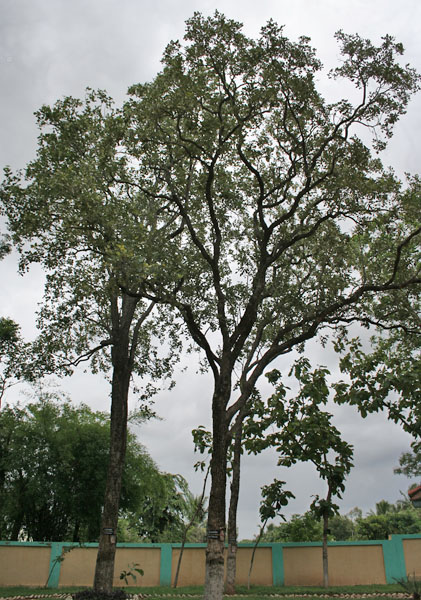- Pterocarpus santalinus
Taxobox
name = "Pterocarpus santalinus"

image_caption = inTalakona forest, inChittoor District ofAndhra Pradesh ,India .
status =
status_system =
regnum =Plant ae
divisio = Magnoliophyta
classis = Magnoliopsida
ordo =Fabales
familia =Fabaceae
subfamilia =Faboideae
tribus =Dalbergieae
genus = "Pterocarpus "
species = "P. santalinus"
binomial = "Pterocarpus santalinus"
binomial_authority = L.f."Pterocarpus santalinus" (Red Sanders or Red Sandalwood; "Rakta chandana") is a species of "
Pterocarpus " native toIndia .International Legume Database & Information Service: [http://www.ildis.org/LegumeWeb?version~10.01&LegumeWeb&genus~Pterocarpus&species~santalinus "Pterocarpus santalinus"] ] It is most commonly found in south and southwestern India, notably in the state ofKarnataka .http://www.chinese-furniture.com/cgi-bin/ccf.cgi?stt=stp&pgn=newsletter_archive/newsletter_2.html&id= Chinese Furniture.com newsletter; Volume 1, Number 2; Accessed 2007-04-05] It is a light-demanding smalltree growing to 8 m tall with a trunk 50–150 cm diameter. It is fast-growing when young, reaching 5 m tall in three years even on degraded soils. It is not frost tolerant, being killed by temperatures of −1 °C. The leaves are alternate, 3–9 cm long, trifoliate with three leaflets. Theflower s are produced in shortraceme s. Thefruit is a pod 6–9 cm long containing one or twoseed s. [Herbalcureindia: [http://www.herbalcureindia.com/herbs/pterocarpus-santalinus.htm "Pterocarpus santalinus"] ] [FAO Ecocrop: [http://ecocrop.fao.org/gppis.exe$EC_Show?Host=9049 "Pterocarpus santalinus"] ] [Auroville: [http://tcdc.undp.org/sie/experiences/vol3/Wasteland%20reclamation.pdf Wasteland reclamation through rehabilitation of eroded soil (pdf file)] ]Uses
The
wood is valued inChina , referred to in Chinese as "zitan". It has been one of the most prized woods for centuries.http://www.wctg.net/zitan.html; Accessed 2007-04-06] Due to its slow growth and rarity,furniture made from zitan is difficult to find and can be expensive . Between the 17th and 19th centuries in China the rarity of this wood led to the reservation of zitan furniture for theQing dynasty imperial household.The other form of "zitan" is from the species "
Dalbergia luovelii ", "Dalbergia maritima ", and "Dalbergia normandi ", all similar species named in trade as bois de rose or violet rosewood which when cut are bright crimson purple changing to dark purple again it has a fragrant scent when worked.References
Wikimedia Foundation. 2010.
